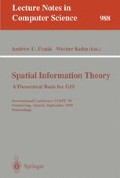Abstract
A framework for the representation of qualitative distances is developed inspired by previous work on qualitative orientation. It is based on the concept of “distance systems” consisting of a list of distance relations and a set of structure relations that describe how the distance relations in turn relate to each other. The framework is characterized by making the role of the “frame of reference” explicit, which captures contextual information essential for the representation of distances. The composition of distance relations as main inference mechanism to reason about distances within a given frame of reference is explained, in particular under “homogeneous structural restrictions”. Finally, we introduce articulation rules as a way to mediate between different frames of reference.
Preview
Unable to display preview. Download preview PDF.
References
Allen, J. F. (1983). Maintaining knowledge about temporal intervals. Communications of the ACM, 26(11), 832–843.
Clementini, E. and Di Felice, P. (1995). A comparison of methods for representing topological relationships. Information Sciences. To appear.
Clementini, E., Di Felice, P., and Hernández, D. (1995). Qualitative representation of positional information. In preparation.
Clementini, E., Di Felice, P., and van Oosterom, P. (1993). A small set of formal topological relationships suitable for end-user interaction. In Abel, D. and Ooi, B. C., editors, Third International Symposium on Large Spatial Databases, SSD '93, Volume 692 of Lecture Notes in Computer Science, pages 277–295. Springer, Berlin.
Egenhofer, M. J. and Franzosa, R. (1991). Point-set topological spatial relations. International Journal of Geographical Information Systems, 5(2), 161–174.
Egenhofer, M. J. and Herring, J. (1991). Categorizing binary topological relationships between regions, lines, and points in geographic databases. Technical report, University of Maine, Department of Surveying Engineering.
Frank, A. U. (1992). Qualitative spatial reasoning with cardinal directions. Journal of Visual Languages and Computing, 3, 343–371.
Freksa, C. (1992). Using orientation information for qualitative spatial reasoning. In Frank, A. U., Campari, I., and Formentini, U., editors, Theories and Methods of Spatio-Temporal Reasoning in Geographic Space. Intl. Conf. GIS—From Space to Territory, Pisa, Volume 639 of Lecture Notes in Computer Science, pages 162–178. Springer, Berlin.
Freksa, C. and Röhrig, R. (1993). Dimensions of qualitative spatial reasoning. In Piera Carreté, N. and Singh, M. G., editors, Proceedings of the III IMACS International Workshop on Qualitative Reasoning and Decision Technologies—QUARDET'93, Barcelona, pages 483–492. CIMNE, Barcelona.
Hernández, D. (1991). Relative representation of spatial knowledge: The 2-D case. In Mark, D. M. and Frank, A. U., editors, Cognitive and Linguistic Aspects of Geographic Space, NATO Advanced Studies Institute, pages 373–385. Kluwer, Dordrecht.
Hernández, D. (1994). Qualitative Representation of Spatial Knowledge, Volume 804 of Lecture Notes in Artificial Intelligence. Springer, Berlin.
Hobbs, J. R. (1985). Granularity. In Joshi, A., editor, Proceedings of the Ninth International Joint Conference on Artificial Intelligence, Los Angeles, CA, pages 432–435. International Joint Conferences on Artificial Intelligence, Inc., Morgan Kaufmann, San Mateo, CA.
Latecki, L. and Röhrig, R. (1993). Orientation and qualitative angle for spatial reasoning. In Bajcsy, R., editor, Proceedings of the Thirteenth International Joint Conference on Artificial Intelligence, Chambéry, France, pages 1544–1549. International Joint Conferences on Artificial Intelligence, Inc., Morgan Kaufmann, San Mateo, CA.
Lowe, J. C. and Moryadas, S. (1975). The Geography of Movement. Houghton Mifflin, Boston.
Mavrovouniotis, M. L. and Stephanopoulus, G. (1988). Formal order-of-magnitude reasoning in process engineering. Computer Chemical Engineering, 12, 867–880.
Mukerjee, A. and Joe, G. (1990). A qualitative model for space. In Proceedings of the Eighth National Conference on Artificial Intelligence, pages 721–727. American Association for Artificial Intelligence, AAAI Press/The MIT Press, Menlo Park/Cambridge.
Raiman, O. (1986). Order of magnitude reasoning. In Proceedings of the Fifth National Conference on Artificial Intelligence, pages 100–104. American Association for Artificial Intelligence, AAAI Press, Menlo Park.
Randell, D. A. and Cohn, A. G. (1989). Modelling topological and metrical properties of physical processes. In Brachman, R., Levesque, H., and Reiter, R., editors, Proceedings 1st International Conference on the Principles of Knowledge Representation and Reasoning, pages 55–66. Morgan Kaufmann, San Mateo, CA.
Zimmermann, K. (1991). SEqO: Ein System zur Erforschung qualitativer Objektrepräsentationen. Forschungsberichte Künstliche Intelligenz FKI-154-91, Institut für Informatik, Technische Universität München.
Zimmermann, K. (1993). Enhancing qualitative spatial reasoning—combining orientation and distance. In Frank, A. U. and Campari, I., editors, Spatial Information Theory. A Theoretical Basis for GIS. European Conference, COSIT'93, Marciana Marina, Italy, Volume 716 of Lecture Notes in Computer Science, pages 69–76. Springer, Berlin.
Author information
Authors and Affiliations
Editor information
Rights and permissions
Copyright information
© 1995 Springer-Verlag Berlin Heidelberg
About this paper
Cite this paper
Hernández, D., Clementini, E., Di Felice, P. (1995). Qualitative distances. In: Frank, A.U., Kuhn, W. (eds) Spatial Information Theory A Theoretical Basis for GIS. COSIT 1995. Lecture Notes in Computer Science, vol 988. Springer, Berlin, Heidelberg. https://doi.org/10.1007/3-540-60392-1_4
Download citation
DOI: https://doi.org/10.1007/3-540-60392-1_4
Published:
Publisher Name: Springer, Berlin, Heidelberg
Print ISBN: 978-3-540-60392-4
Online ISBN: 978-3-540-45519-6
eBook Packages: Springer Book Archive

